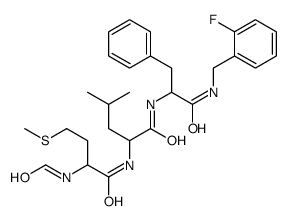N-FORMYL-MET-LEU-PHE-O-FLUOROBENZYLAMIDE

N-FORMYL-MET-LEU-PHE-O-FLUOROBENZYLAMIDE结构式

|
常用名 | N-FORMYL-MET-LEU-PHE-O-FLUOROBENZYLAMIDE | 英文名 | N-FORMYL-MET-LEU-PHE-O-FLUOROBENZYLAMIDE |
|---|---|---|---|---|
| CAS号 | 112898-02-9 | 分子量 | 544.68100 | |
| 密度 | N/A | 沸点 | N/A | |
| 分子式 | C28H37FN4O4S | 熔点 | N/A | |
| MSDS | 中文版 美版 | 闪点 | N/A |
|
The synthetic chemoattractant Trp-Lys-Tyr-Met-Val-DMet activates neutrophils preferentially through the lipoxin A(4) receptor.
Blood 95 , 1810-1818, (2000) A D-methionine-containing peptide, Trp-Lys-Tyr-Met-Val-D-Met-NH(2) (WKYMVm), featuring a unique receptor specificity was investigated with respect to its ability to activate neutrophil effector functions. The peptide was found to be more potent than the N-for... |
|
|
Conformational energy analysis of the chemotactic tripeptide formyl-Met-Leu-Phe and three analogs.
Int. J. Pept. Protein Res. 34 , 229-234, (1989) Conformational energy analyses were carried out on the chemotactic tripeptide fMLF (CHO-Met-Leu-Phe) and three analogs fALF (CHO-Ala-Leu-Phe). fMF (CHO-Met-Phe), and MLF (H-Met-Leu-Phe). A near-folded or puckered conformation predominates in all four peptides... |
|
|
Glia maturation factor-γ mediates neutrophil chemotaxis.
J. Leukoc. Biol. 90 , 529-538, (2011) Chemotaxis is fundamental to the directional migration of neutrophils toward endogenous and exogenous chemoattractants. Recent studies have demonstrated that ADF/cofilin superfamily members play important roles in reorganizing the actin cytoskeleton by disass... |
|
|
Stimulation of human formyl peptide receptors by calpain inhibitors: homology modeling of receptors and ligand docking simulation.
Arch. Biochem. Biophys. 516 , 121-127, (2011) Calpain inhibitors, including peptide aldehydes (N-acetyl-Leu-Leu-Nle-CHO and N-acetyl-Leu-Leu-Met-CHO) and -mercapto-acrylic acid derivatives (PD150606 and PD151746), have been shown to stimulate phagocyte functions via activation of human formyl peptide rec... |
|
|
Anti-formyl peptide antibodies.
Bioorg. Med. Chem. Lett. 17 , 1943-1945, (2007) Antibodies that selectively bind to N-formylmethionyl leucyl phenylalanine (fMLF, also known as fMLP) have been generated. These antibodies bound to fMLF with higher affinity than to non-formylated peptide MLF: the differences in the binding energies between ... |